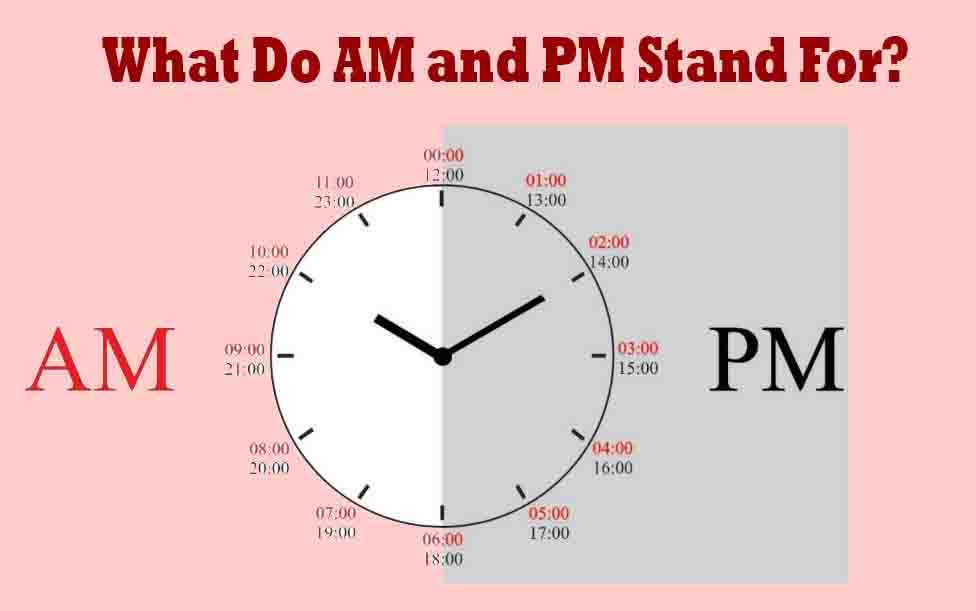Many of the English words and expressions we use every day can trace their origins back to Latin. These include some of the English language’s most perplexing abbreviations and acronym examples such as “lb,” “No,” and “No. an abbreviation for the decidedly O-less word “number” is called a numeral. And, if you’ve ever wondered, “What do AM and PM stand for?” Look no further, they come from Latin. (By the way, what’s the difference between acronym vs abbreviation?

Table of Contents
How to Punctuate AM and PM
In the United States and several other English-speaking countries we use these abbreviations all the time.
To get the perfect sleep, we need to use them correctly. “AM” stands for “ante meridiem,” which is a Latin phrase meaning “before noon.” In the 12-hour clock, this is the time from midnight to 11:59:59 p.m. (and in most parts of the world it is already morning). All times after that use the 12-hour system.
In ancient Rome, the PM was a period of time when the ruler was required to stop performing official duties and instead be with his or her family or devote themselves to leisure pursuits.
The United States and Canada have been using the “AM” and “PM” abbreviations since the 17th century. The Latin word “post” has also made its way into our language as a standalone word. It means “after.” To understand why we have daylight saving time, find out why we have it.
AM and PM in Military Time
In 24-hour time, AM and PM do not come after any numbers at all so there are no duplicates. Instead of doing that annoying thing of counting to 1, you do 12:59 (PM). Then you go to the next day at 13:00.
It’s not midnight yet, and the hour just after midnight isn’t different; it’s actually the 12th. From midnight (00:00 AM) until midnight (12:00 AM), you have the option to change the number from twelve to zero.
If you’re in military time, any time that begins with zero is 12-something A.M.
To translate military time into post-12:59 PM time, add 12 to the hour number.
If you’re in military time, add 12.
You may think the time 21:39 looks strange, but it actually works out to be 15:39. It seems to be backwards, because it says 3:
Subtract 12 from the hour to get 9:39 PM. The last minute is dicey, but you should be fine.
This can be a good way to tell the difference between the preceding midnight and the end of that day. Or the beginning of a certain day and the end of that day.
What About Noon and Midnight?
The most confusing aspect of the AM-PM system, once you’ve answered the question “What do AM and PM mean,” is how midnight and noon are treated. Using military time can be confusing because you have two “o’clocks” a day. That’s definitely an argument for using military time. Which 12-hour system?
I’d say that technically, the 12:00 at night, or 12AM, is considered to be exactly twelve hours after the previous noon, and is therefore considered to be “after” the time of noon. The same would apply to the 12:00 at midnight, or 12PM.
And, of course, 12:00 PM is noon, so it might seem silly to designate it “before” or “after.” In the US, we consider that midnight is “before noon” of the next day. And if time went from 12:00 PM to 12:01 AM. Noon is 12 PM, since the 12th hour is never 12 PM.
If you feel strongly about using “noon” instead of “after noon,” use the Latin abbreviated form of the phrase “post meridiem. When you’re trying to figure out what the time it is, this is the way you look at the clock. It may not mean a thing to you, but for better or worse, the “12 M” designation for “noon” is very rare and has been pretty much lost to antiquity.If the answer to the question “What do AM and PM mean” surprised you, you’ll want to learn about the “P.S.”
Conclusion
In conclusion, If you want to write content that will increase traffic and conversions, then you have to understand the psychology of your audience. People are attracted to certain types of content and not others. And this is where the psychology of AM and PM comes into play.
FAQs
The difference between AM and PM is that AM is for morning and PM is for evening.
“Good morning” means that it’s a good day and you should be happy. “Good night” means that it’s a good night and you should sleep well.
When you say goodbye, you’re saying that you’ll see each other again.
We ask this question because when we wake up in the morning, we want to know what time it is so we can get ready for the day.
1.
2.
3.
4.
